Imi Knoebel


b. 1940, Germany
One of the leading German artists of the post-war period, Imi Knoebel's wide-ranging and rigorous oeuvre incorporates drawing, painting, sculpture, photography, projections and installation. Born as Klaus Wolf Knoebel in Dessau in 1940 he studied under the tutelage of Joseph Beuys at the Düsseldorf Art Academy and was assigned, together with his friend Imi Giese, its legendary 'Raum 19'.
Knoebel's art is resolutely abstract, continuing Malevich's notion of “pure perception” through the exploration of form, colour and material. “When I am asked about what I think when I look at a painting” he has said, “I can only answer that I don't think at all; I look at it and can only take in the beauty, and I don't want to see it in relation to anything else. Only what I see, simply because it has its own validity.” Often producing work in groups or series, his minimal compositions rely on a pared down, strict vocabulary of forms combined with a subtle and commanding use of colour, exposing the physical possibilities inherent in the most basic of materials, such as plywood, aluminium and fibreboard. This is exemplified by the large installation Raum 19, created while Knoebel was still a student under Joseph Beuys and now part of Dia Beacon’s permanent collection. Borrowing its title from the number of his studio at the Kunstakademie, it consists of 184 wood and fibreboard forms such as frames or stretchers, cylinders, cubes and rectangles which can be stacked, layered and reconfigured in any number of different ways. Unpainted and left in their raw material state, this constellation of neutrally coloured, humble components suggests both the potential for future use as well as the reduction of art to its basic material elements.